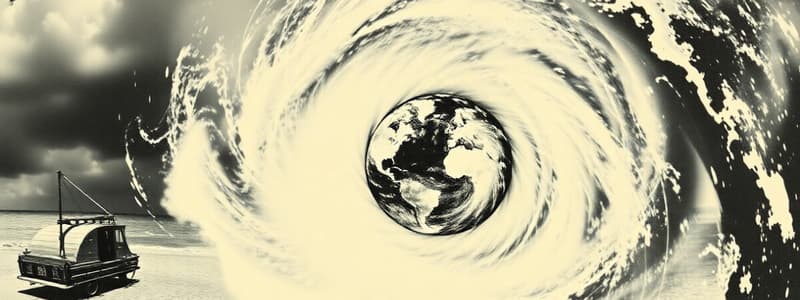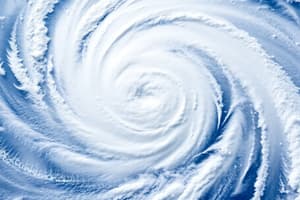Podcast
Questions and Answers
How does the Coriolis force affect wind movement in the northern hemisphere?
How does the Coriolis force affect wind movement in the northern hemisphere?
- It has no effect on wind direction.
- It deflects wind to the left.
- It only affects wind at the equator.
- It deflects wind to the right. (correct)
What is the primary effect of the pressure gradient force on wind velocity?
What is the primary effect of the pressure gradient force on wind velocity?
- The higher the pressure gradient force, the greater the wind velocity. (correct)
- It causes wind to blow perpendicular to isobars.
- It decreases wind velocity near high pressures.
- It is directly proportional to the wind deflection.
Which of the following statements is true about cyclonic and anti-cyclonic circulation?
Which of the following statements is true about cyclonic and anti-cyclonic circulation?
- Cyclonic circulation leads to divergence of air.
- Anti-cyclonic circulation occurs around low-pressure systems.
- Cyclonic circulation occurs around high-pressure systems. (correct)
- Anti-cyclonic circulation involves rising air.
At which location is the Coriolis force absent?
At which location is the Coriolis force absent?
What happens to air in low-pressure areas according to the described wind circulation?
What happens to air in low-pressure areas according to the described wind circulation?
What happens to the warm air when a cold front overtakes a warm front?
What happens to the warm air when a cold front overtakes a warm front?
Which characteristic distinguishes extra tropical cyclones from tropical cyclones?
Which characteristic distinguishes extra tropical cyclones from tropical cyclones?
In which latitudes do extra tropical cyclones commonly occur?
In which latitudes do extra tropical cyclones commonly occur?
What indicates the contact zone when warm air moves towards a cold air mass?
What indicates the contact zone when warm air moves towards a cold air mass?
What is the result of the abrupt changes caused by the passing of a front?
What is the result of the abrupt changes caused by the passing of a front?
What occurs when an air mass is fully lifted above the land surface?
What occurs when an air mass is fully lifted above the land surface?
During extra tropical cyclone formation in the northern hemisphere, which direction does the warm air move?
During extra tropical cyclone formation in the northern hemisphere, which direction does the warm air move?
What type of weather changes are typically observed in the area affected by extra tropical cyclones?
What type of weather changes are typically observed in the area affected by extra tropical cyclones?
Which type of air mass is characterized by warm temperatures and high humidity?
Which type of air mass is characterized by warm temperatures and high humidity?
Which air mass is likely to cause the most intense cold weather conditions?
Which air mass is likely to cause the most intense cold weather conditions?
Which type of air mass is associated with dry and high temperature conditions?
Which type of air mass is associated with dry and high temperature conditions?
What characterizes the source regions for air masses?
What characterizes the source regions for air masses?
How are air masses classified?
How are air masses classified?
Which of the following air masses comes from relatively cold high latitude oceans?
Which of the following air masses comes from relatively cold high latitude oceans?
Which air mass has the least effect on temperature due to its origin?
Which air mass has the least effect on temperature due to its origin?
What is a characteristic of continental polar (cP) air masses?
What is a characteristic of continental polar (cP) air masses?
Which type of air mass is expected to bring warm, humid conditions from the ocean?
Which type of air mass is expected to bring warm, humid conditions from the ocean?
What atmospheric condition prevents tropical cyclones from forming near the equator?
What atmospheric condition prevents tropical cyclones from forming near the equator?
Which of the following best describes the factors affecting the pattern of planetary winds?
Which of the following best describes the factors affecting the pattern of planetary winds?
What describes geostrophic wind behavior?
What describes geostrophic wind behavior?
Which factors contribute to the creation of fronts in the atmosphere?
Which factors contribute to the creation of fronts in the atmosphere?
Which front is characterized by the warm air being pushed up over cooler air?
Which front is characterized by the warm air being pushed up over cooler air?
What primarily causes winds in the upper atmosphere?
What primarily causes winds in the upper atmosphere?
Which statement about occluded fronts is true?
Which statement about occluded fronts is true?
What is one effect of the Earth's rotation on atmospheric conditions?
What is one effect of the Earth's rotation on atmospheric conditions?
What is the term used for the boundary zone where two different air masses meet?
What is the term used for the boundary zone where two different air masses meet?
What is a characteristic of an extra-tropical cyclone?
What is a characteristic of an extra-tropical cyclone?
What role does the pressure gradient play in wind generation?
What role does the pressure gradient play in wind generation?
What is the process of formation of fronts called?
What is the process of formation of fronts called?
Which type of front occurs when a cold air mass pushes into a warm air mass?
Which type of front occurs when a cold air mass pushes into a warm air mass?
Which statement best describes an occluded front?
Which statement best describes an occluded front?
What type of clouds are typically associated with the passage of a cold front?
What type of clouds are typically associated with the passage of a cold front?
What is a characteristic feature of a warm front?
What is a characteristic feature of a warm front?
In a well-developed extratropical cyclone, what role do warm sectors play?
In a well-developed extratropical cyclone, what role do warm sectors play?
Which type of circulatory pattern is typically present in an extratropical cyclone?
Which type of circulatory pattern is typically present in an extratropical cyclone?
What happens to precipitation patterns ahead of a warm front?
What happens to precipitation patterns ahead of a warm front?
What describes a stationary front?
What describes a stationary front?
Flashcards are hidden until you start studying
Study Notes
Atmospheric Circulation and Weather Systems
- The movement of cold and warm air masses results in various weather patterns
- Cold Front: A boundary zone where cold air moves towards warm air
- Warm Front: A boundary zone where warm air moves towards cold air
- Occluded Front: When a cold front overtakes a warm front, forcing the warm air upwards
- Extra Tropical Cyclones: Form in mid and high latitudes, characterized by a clear frontal system
- Formation Process: They form along stationary polar fronts where warm air from the south meets cold air from the north
- Characteristics: Have a warm front and a cold front, creating abrupt weather changes
- Cyclonic Circulation: Anticlockwise rotation in the Northern Hemisphere, clockwise in the Southern Hemisphere
- Tropical Cyclones:
- Differ from extra-tropical cyclones: They lack a clear frontal system and form over the oceans
- Formation: Originate over warm tropical waters and are associated with low pressure areas
- Structure: Can be visualized through a schematic representation with a clear vertical structure
- Air Masses: Large bodies of air with little horizontal variation in temperature and moisture
- Formation: Air masses acquire characteristics of the homogenous regions they form over, such as oceans or plains
- Classification: Classified based on their source regions, such as maritime tropical (mT), continental tropical (cT), maritime polar (mP), continental polar (cP), and continental arctic (cA)
- Frontogenesis: The process of forming fronts, characterized by a steep temperature and pressure gradient
- Types of Fronts: Consist of cold, warm, stationary, and occluded fronts
- Land and Sea Breezes: Local winds caused by temperature differences between land and sea
- Sea Breeze: During the day, land heats faster, creating low pressure and wind blowing from the cooler sea to land
- Land Breeze: During the night, land cools faster, creating high pressure and wind blowing from the warmer sea to land
- Mountain and Valley Winds: Local winds generated by temperature differences between mountain slopes and valleys
- Valley Wind: During the day, mountain slopes heat up, creating upslope airflow and wind blowing from the valley to the slopes
- Mountain Wind: At night, slopes cool down, creating downslope airflow and wind blowing from the mountain slopes to the valleys
- Coriolis Force: A force that results from the Earth's rotation, deflecting wind directions
- Direction: Deflects wind to the right in the Northern Hemisphere and to the left in the Southern Hemisphere
- Intensity: The deflection is more pronounced with higher wind velocities and at higher latitudes
- Pressure Gradient Force: A force that drives air from high pressure areas to low pressure areas
- Geostrophic Wind: Wind that blows parallel to isobars when the pressure gradient force and Coriolis force are balanced
- General Circulation of the Atmosphere: The global pattern of planetary winds, influenced by several factors, such as latitudinal variation of atmospheric heating, pressure belts, and the rotation of the Earth
- Convergence and Divergence of Winds: Related to wind circulation around low and high pressure areas
- Convergence: Air flows into a low pressure area, causing upward movement and contributing to cloud formation and precipitation
- Divergence: Air flows out of a high pressure area, causing downward movement and clear skies
- Relationship between Wind Circulation and Weather: Wind circulation creates the conditions necessary for cloud formation and precipitation. For example, convergence leads to upward movement, which cools the air, causing condensation and cloud formation.
Studying That Suits You
Use AI to generate personalized quizzes and flashcards to suit your learning preferences.



